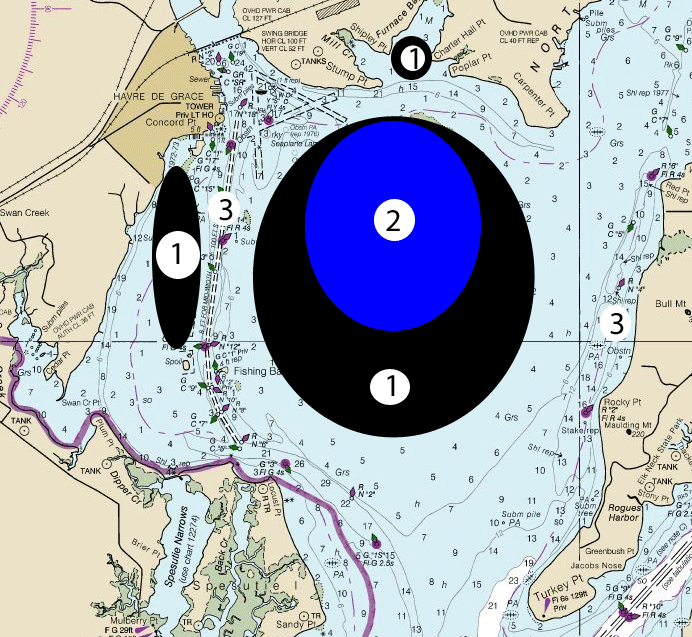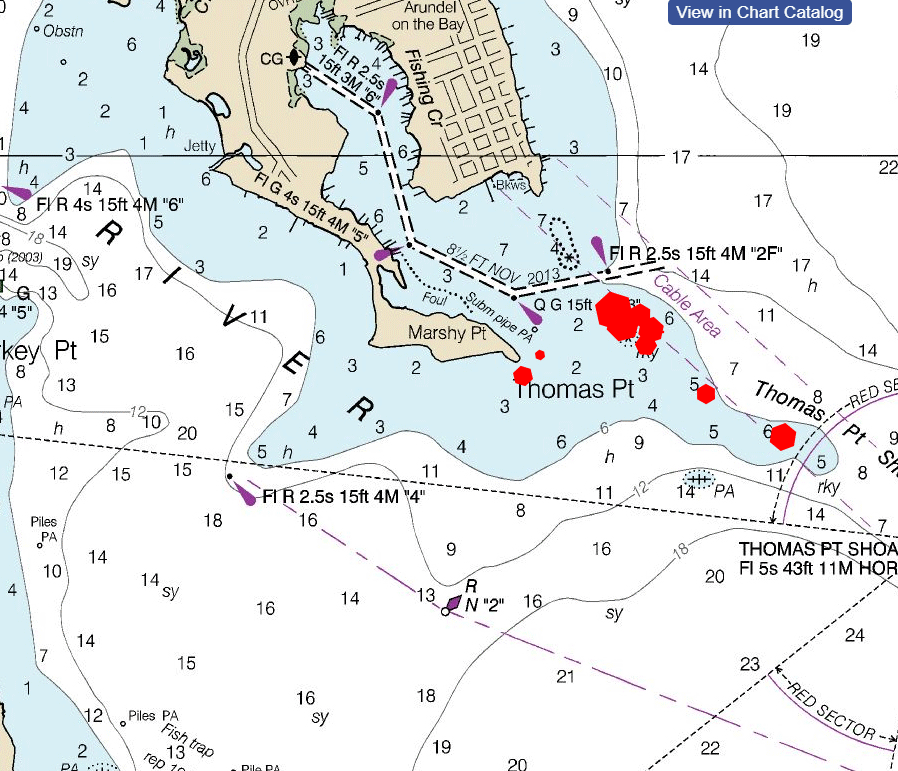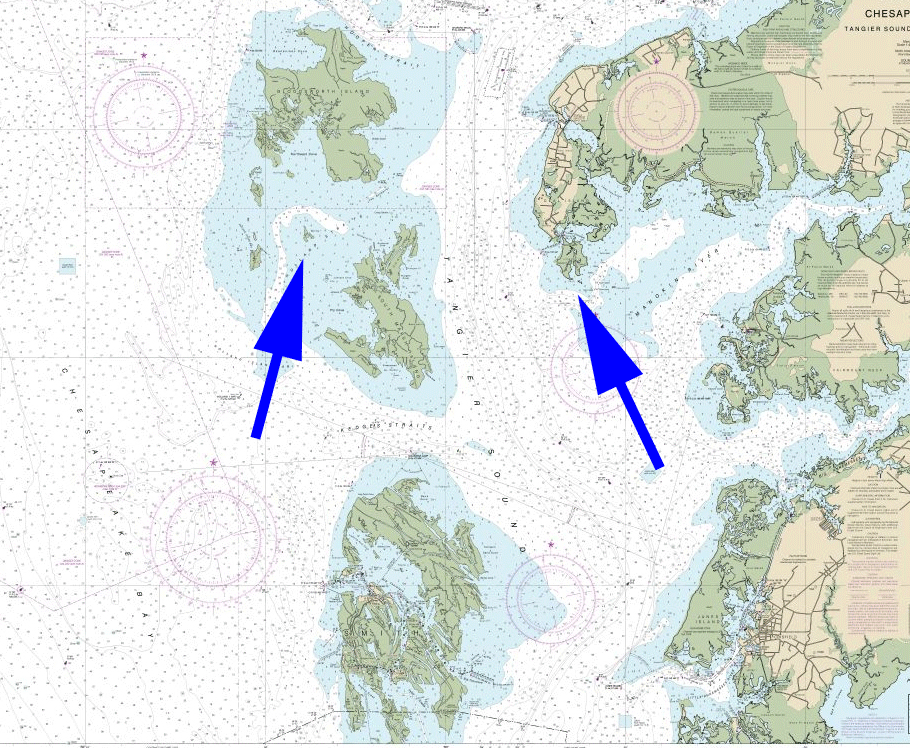We covered the how-to aspects of fishing for rockfish in Fishing Light Tackle for Stripers in Shallow Water, Part I, so now it’s time to look in detail at some of the best spots (from north to south) in the Mid-Atlantic region to give this type of fishing a try. But first we need to note that seasonality has a big effect on how good the fishing will or will not be at any of these spots. We also need to remember that from year to year, any one given spot can be red-hot or ice-cold. So we’ll also rank these locations based on past experience, and tell you up-front how likely they are to produce in any given year with a “reliability rank” on a scale of one to 10.

The Susquehanna Flats is the undisputed king of all shallow water striper spots, producing more fish over 40 inches than all the rest combined. So, why does it have such a low reliability rank? Sudden releases of water from the Conowingo dam can shut down the fishing here in a heart-beat. Some years the months of March and April (April’s usually prime-time) provide non-stop action on huge fish, and other years nature and the floodgates conspire to make these waters un-fishable for that entire time-frame. There’s simply no way to predict it in advance, much less one day to the next, so anglers who want to try their hand at casting the shallows of the flats need to stay up to date with local fishing reports—especially by checking out our Way North Reports pages.
One more thing about seasonality: there is a closure period on the flats at certain times in the spring, and there are special rules and regulations regarding how you fish here (especially for bait anglers). Our crack legal team (thanks, Dad) has advised us to always remind our readers to check with the DNR for the latest rules and regs.
Which specific part of the flats should you target? This can and will change on a daily basis. There are two key items to look for: the best water clarity, and the highest temperature. When it comes to clarity, while the biggest influence comes from those floodgates, wind is another important factor to keep in mind. Down-wind areas of the flats will commonly be more churned up than up-wind areas, and deeper areas are slightly less susceptible to wind-churn than the shallower areas. Predicting where you’ll find pockets of warmer water—which often are sought out by the fish—is a bit more difficult. As long as the water temps are below about 62-degrees, however, stripers will seek out and stick with patches of water that are two or more degrees warmer than surrounding areas. When the temps are low keep a close eye on your fishfinder’s temperature gauge, and move around constantly until you find a temperature change or start getting bites.

Thomas Point gets a super-high reliability ranking because virtually every year for about a two week period during the month of November, it sees a run of stripers in the mid-30-inch class. Most seasons a few trophy-sized fish are also taken here in the spring, and from June through November, about half the seasons the shallows here will support a good fishery for school-sized fish.
For some reason, the largest fish taken from Thomas Point—especially during that November bite—are caught on large topwater lures. School-sized fish will hit topwater, too, but anglers looking to fill the box often do better tossing four to six inch plastics on half or quarter-ounce jigheads. The bottom in many areas is rocky and snaggy, so keep your lures fast and high. Be careful while motoring through here, too, especially on a low tide, because there are some prop-eating rockpiles (see chart).
While your there, also be sure to take a few casts at the Thomas Point lighthouse rocks. These usually hold smaller fish (usually - not always) and get hit hard by a large number of boats, but are still worth checking out.

There’s endless shoreline in the lower and middle Choptank River, and much of it holds stripers. The rocks at Hambrook Bar, the mouths of Reeds and Holmes creeks, Nelson Point, and many other rip-rapped areas are all good bets for working the shallows during most fall seasons. But perhaps the best spot to cast for stripers is of Todd Point, where there’s a submerged rockpile (lore says it was once the foundation of a lighthouse, and the rocks are laid out in a distinctly rectangular shape). One rockpile alone wouldn’t be enough to rate a mention in this article, since a single boat or perhaps two is all the pressure it can support at any given time. But starting at the rockpile and stretching for hundreds of yards parallel to the shoreline there’s a long stretch of rocks sitting in an east-west line. This provides a much more extensive territory for anglers to work through, and at different times, the entire stretch may hold fish.

Although many people think of speckled trout and redfish when the marsh islands of the Tangier Sound come up in conversation, truth be told, on an average day during an average season you’ll commonly catch stripers at a rate of three, five, or even 10 to one as compared to these other species. In fact, often during the months of May and June, and again in October, catches of 50 or 100-plus stripers are possible. True, most of these will likely be on the small side. But when it comes to sheer numbers of stripers in the shallows, the Tangier will be tough to beat.
The most important thing to keep in mind when searching for stripers along the banks of Bloodsworth, Spring, South Marsh, Little Deal, Smith, Tangier, Janes, and Fox Islands, is the current. The endless points and creek mouths of these tidbits of land protruding into the sound create visible rips, and in these rips is often where you’ll find the best bite. Other areas with structure, like rockpiles and rip-rap or stump-fields, certainly also hold their share of fish. But it’s possible for an angler with little experience to come to the Sound, run to any one of these islands, and visually identify numerous productive rips right along the shorelines.

The Hampton Roads Bridge Tunnel (HRBT) is an excellent area to try in the fall, both on the northern and southern sides. The islands are rip-rapped, the bridge pilings often hold fish, and near-by shorelines do as well. A special attraction here is the night-bite, provided courtesy of a light-line cast by the bridge illumination. Since there’s public access very close by at Willoughby Landing this zone is popular among kayak anglers, too.
You do need to be careful, particularly around the bridges themselves, because there’s a combination of shallow water and fast-flowing currents in some areas. Naturally, that’s why the fish like it here, too. Just don’t forget to bring some larger jig heads to make up for the fast-moving water, and if you want to try topwater at night, be sure to bring a black stick-bait and walk-the-dog along the edges of the light-line. Expect most of the fish you encounter to be in the low- to mid-20-inch range, though especially later in the year, larger stripers do pop up here.
-By Lenny Rudow
Sign up here to get the weekly FishTalk Chesapeake Bay and Mid-Atlantic fishing reports in your email inbox, every Friday by noon.